Aquatic turtles are one of the messiest aquarium pets and no one wants their hobby to turn into a chore.

Here’s a scenario for you: you recently became the owner of a new turtle tank but its water has become a cloudy white color and now smells like a public restroom.
Also, no matter how much cleaning effort you put in, your red-eared slider somehow manages to make things incredibly dirty again.
But what if I told you that, though regular maintenance is key, preserving clear tank water can be done with far less work on your end? What’s the best way to keep the water in a turtle tank clean and how to do it in a smart way?
See Also: The 14 Types of Freshwater Turtles: The Best Aquarium Companions for a comprehensive list of the most popular pet turtle varieties!
How to keep a turtle aquarium sanitized and clean?
Establishing some form of continuous mechanical filtration alongside balanced bacterial colonies in the water should be your top concern.
Each method included here aims to do either or both.
If you don’t stay on top of the maintenance the water in your turtle tank will get dirty pretty quickly. That’s because turtles eat, pee, and poop a lot, and they do it all in the same water.
Here’s how to keep a turtle tank clean and sanitized:
1. Install a strong canister filter for aquariums.
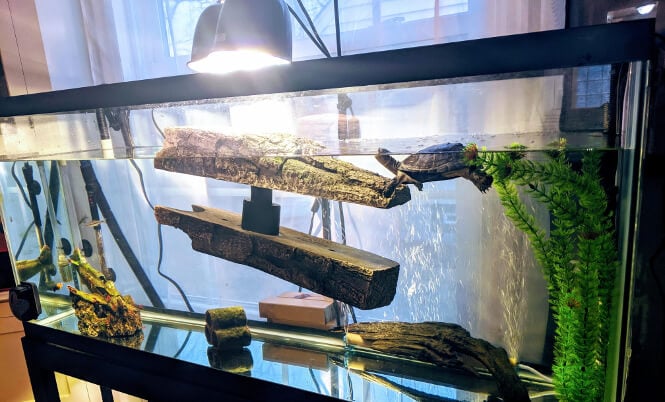
Aquatic turtles are messy, relative to their body mass, and are constantly producing considerable amounts of waste. Despite sometimes acting filthy, turtles don’t enjoy living in dirty water and as their owners we must provide them the best possible living conditions.
One of the best ways to maintain the water in a turtle tank clean is by setting up a strong canister filter.
Canister filters are composed of a cartridge with filter media, a motor, an inlet, and an outlet hose.
They are usually recommended for freshwater setups overstocked with large carnivorous fish or aquatic turtles. That’s because these creatures generally produce more waste in the aquarium.
Canister filters pump large volumes of water, which gets mechanically and biologically purified through their massive trays, containing various filter media. Setting one such device is a sure way to significantly reduce a turtle tank’s maintenance while making sure that its water remains clean for longer periods of time.
Having the right filter media in place also helps with keeping turtle tank water clean. Filter floss is one type of media that any turtle owner should have in their filter. Filter floss is very good at filtering impurities which helps with achieving crystal clear aquarium water.
To choose the best canister filter according to the volume of the turtle aquarium relative to the filter’s pumping capacity visit here.
2. Vacuum turtle poop and food leftovers from the bottom at least 4 times a month.
Both turtle poop and the food your turtle leaves behind with each meal can accumulate with time, causing the water in the tank to get polluted with ammonia or nitrate.
A higher concentration of ammonia is toxic to aquatic pets and should not be overlooked. Having more nitrate in the aquarium usually leads to unsightly algae issues.
See, a special set of bacteria in the aquarium immediately gets to work when some form of organic matter is left unutilized.
They “mineralize” food leftovers or waste, converting these to ammonia. Then, another set of bacteria transforms the ammonia into nitrite and then a third set converts that to less harmful compounds such as nitrate. That’s called a nitrogen cycle.
Here’s a visual representation of the nitrogen cycle in a turtle tank:

When you keep the bottom of the tank clean by vacuuming it, you do not allow for dangerous ammonia fluctuations that may harm your aquatic turtle pet. Vacuuming the bottom of a turtle tank is easiest when done with a special hose-like gravel vacuum that’s also used for fish aquariums.
Make sure your substrate vacuum has a long nozzle because the shorter ones do not provide a convenient reach and the cleaning task becomes somewhat annoying.
Another thing to look for in one is that it’s made from safe, BPA-free plastic. This is important in order to avoid the possibility of leaking harmful substances in the turtle tank’s water from low-quality plastics.
I can recommend using this substrate vacuum cleaner or a similar one because it meets both requirements and is also rather inexpensive.
To remove turtle poop from the aquarium you could also gently scoop it with a fish net from the bottom. Make sure to scoop as much poop particles as you can and carefully export it from the tank. Cleaning the turtle habitat like that once a week immensely helps with keeping its water clear in the long run.
This is because the filter will have its own internal media that eventually gets colonized by a huge number of beneficial bacteria. The more bacteria there is in the tank – the quicker ammonia is handled and neutralized.
This helps with keeping the tank’s water ammonia-free, despite the turtles inside who keep producing waste.
3. Sterilize the water with UV light to avoid harmful free-floating pathogens.
Let me start this section by just pointing out that constantly sterilizing the water in a turtle aquarium is not necessary and should only be done when needed.
Another thing I need to make clear from the beginning of this section is that this type of water sterilization cannot be achieved through the UVB lamp that your turtle uses for basking.
You’ll need a separate device, called a UV water sterilizer.
Anyway, at times, when an aquarium has accumulated excessive organic matter the water will become cloudy or even green.
This means that there’s an abundance of unutilized food sources lying around for single-celled organisms or bacteria. Most common reason for that to happen is overfeeding your pet turtle or not cleaning the substrate often enough.
Anyway, said organisms begin to aggressively multiply to take advantage of the feast.
Once that happens it becomes very difficult to put their numbers under control.
This could lead to a turtle tank that constantly has murky water and is smelly.
In a turtle tank, green water is caused by microalgae spores and cloudy water is the result of free-floating heterotrophic bacteria.
Note that the bacteria causing hazy water, in that case, are not the ones we call beneficial nitrifiers.
See how the right turtle tank filter makes maintenance easier by checking out this article.
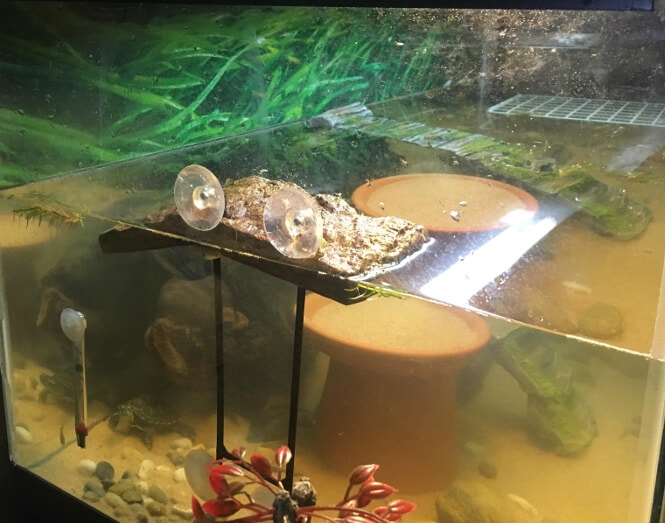
What I’d like to point out is that cloudy or green water in a turtle tank typically takes weeks to naturally fix itself, if at all.
These conditions are not harmful to a turtle pet but the overall look of the tank is somewhat compromised.
Also, such dirty aquarium water is usually accompanied by a foul smell, which is not good to have at home.
Aquatic turtles are a known carrier of salmonella which in turn can be dangerous for the person who’s dealing with the tank’s maintenance.
Except when dealing with salmonella or other diseases, the water will eventually restore the balance and clear itself if left on its own.
However, other disease and parasitic activities from poor water maintenance in a turtle tank can result in:
- Damage to the eyesight of your turtle pet
- Shell infections
- A yellow build-up in the turtle’s ears
- Skin infections and fungi
- Respiratory issues
- Digestive difficulties and parasitic worms
These are often present when a beginner turtle owner remains uninformed of the level of care and cleaning a water tank requires.
A UV sterilizer can, therefore, come in handy and more experienced turtle keepers prefer to occasionally use one.
Treating the water in a turtle tank with UltraViolet light wipes out free-floating algae, excess undesired bacteria, and harmful pathogens all at once. In the case of an outbreak, a UV sterilizer with an adequate bulb intensity can take care of the problem in just 3 to 4 days. A UV light sterilizer is also one of the best ways to remove and prevent foul water smell in a turtle aquarium.
It’s worth noting that if your aquatic turtle is already sick sterilizing the water with UV light will only take care of the vermin that are free-floating.
It will not remove them from the turtle’s body and you should actually move the pet to a different hospital tank and treat it there.
When getting a UV sterilizer to prevent all of this you should purchase one with a bulb intensity that adequately matches the gallon capacity of your turtle tank.
If the bulb is too weak or the pump of the UV sterilizer is not strong enough, it could be very difficult to clear up all of the water in the tank.
Getting an overpowered device, on the other hand, will produce the desired results – just faster.
To spare you some time for research I’ve created a detailed guide on exactly that.
Visit this link and find your aquarium’s gallon capacity to see the required Wattage for a matching UV sterilizing bulb.
It’s nothing complicated.
4. Perform regular dechlorinated water changes.
Ideally, you’d want to change 30% of the water in your turtle’s tank every 14 days or so. Regular water changes like that help with exporting organic compounds that make the tank dirty with time.
See, as the nitrogen cycle in every aquarium goes – bacteria will convert ammonia to nitrite, which then will be converted to nitrate.
The first 2 compounds are not good to have in the water of your turtle pet but the third – nitrate – is rather harmless in the short run.
However, it will build up with time and remain in the system, which is not ideal for aquatic pets.
Water changes are a quick fix to that because they clear the aquarium water up by diluting the excess nitrate levels.
But why dechlorinate tap water before pouring it into the aquarium?
Chlorine is supposed to kill harmful bacteria, right?
It’s why drinking water facilities use Chlorine, or its cousin – Chloramine, in the first place, right?
The thing is that Chlorine and Chloramine kill both the good and the bad bacteria. Chloramine is more often used in tap water.
This will keep the beneficial bacteria in the aquarium safe so that they can continue to work on the ammonia and nitrite for you.
To dechlorinate tap water add what’s known as a conditioner to it. One such water conditioner is Seachem Prime but there are many other options.
Author’s note: If you perform regular vacuum cleaning of the bottom with a siphon you are actually removing dirty water too.
Don’t count on filters to remove nitrAte as the bacteria that use it up do not do well in home aquariums. You’ll need to physically remove nitrage via water changes unless you…
5. Add floating freshwater plants to the system.
Aquarium plants will employ ammonia and nitrate as a source of food.
Adding some floating aquarium plants to a turtle tank will reduce the need for maintenance while keeping the water clean.
Though all of the aquatic plant species will do so to a certain degree, the floating ones will be extremely good at it.
This is because floaters have access to way more atmospheric CO2, which is essential for their nutrient exchange processes.
Plants that prefer to grow submerged absorb CO2 slower and in lower quantities, thus sucking up fewer nutrients from the water.
Also, not every aquatic plant is okay for a turtle’s digestive system and many can actually be toxic to your pet.
For this reason, there are 2 main approaches that you can take.
- Add quick-growing plants that are not appetizing for a turtle, but are also free of toxins.
- Connect a separate smaller tank to the main one via tubing and a pump and grow the plants there.
That being said, if you don’t have space or don’t want to set up a separate tank for plants you should just be wise with what you pick.
Here are some good aquatic plants for a turtle aquarium:
- Water lettuce
- Hornwort
- Dwarf duckweed
- Giant duckweed
- Amazon frogbit
Note that depending on the species some plants will remain untouched while others can quickly become lunch.
Water lettuce is ideal for musk turtles, and common snapping turtles, for example.
Amazon frogbit is always a good first try as a floating plant for a turtle aquarium.
If you’re up for connecting another smaller tank to grow plants in, then you can go with whichever floating species.
They all will suck excess nitrates and ammonia extremely well.
In my experience, this option is definitely worth the time because the need for water changes will be almost non-existent and the turtles will have a continuous supply of clean aquarium water to swim in.
A photo of an indoors turtle tank with floating plants inside:

6. Add a cleaning shrimp species in the aquarium.
Another way to keep a turtle tank, and its internal glass walls, sparkling clean is to add shrimp members of the Aquarium Cleanup Crew.
Said crew consists of all kinds of algae-eating shrimp or fish, but the species I’m recommending here is the Ghost Shrimp.
Ghost shrimp will keep the glass and other hard-to-scrape surfaces inside of a turtle aquarium clean.
I’m not recommending any fish for this task because fish do eventually get eaten.
Large enough fish to stand their ground against an aquatic turtle won’t be interested in eating algae actively.
Shrimp, on the other hand, will have nothing better to do, when not chased by your turtle pet.
Truth is that they will eventually become a snack.
However, ghost shrimp, in particular, breed with ease, and if you add a good number to the tank at least a couple will manage to produce offsprings.
They are very cheap, but also less agile than other aquarium shrimp species.
Red cherry shrimp will maintain a turtle tank hygienic, however, their market value is greater.
Red cherry shrimp are more agile than ghost shrimp and stand a better chance of escaping a turtle that’s trying to eat them.
However, in my experience, when it comes to turtle aquariums it’s better to buy lots of cheaper shrimp than a couple of agile ones.
7. Create a strict feeding schedule and don’t overfeed.
Not feeding more than a turtle can eat is generally among the best advice for maintaining clear aquarium water. Overfeeding is one of the most common causes of dirty water in a turtle tank.
To reduce turtle waste you can feed nutrient-rich foods no more than 3 times per week to a juvenile. A juvenile I consider every turtle pet that’s 2 years old or younger. For mature turtles, this can be reduced to 1 time a week.
It’s worth noting that there’s a difference between feeding romaine lettuce and feeder fish.
Greens are low on calories and therefore produce less waste.
Fish meat and other protein-rich foods are densely packed with nutrients.
Red Eared Sliders are more on the herbivorous side and won’t produce a whole lot of waste compared to other turtle species.
Alligator snapping turtles are not as active and require less frequent feeding.
Softshells have a faster metabolism than most and will prefer to eat more often, if possible.
If a turtle tank has a constant supply of plants and other greens to munch on you should not feed meat foods more than twice a week. All things equal, larger mature turtles can be fine with a single protein-rich meal per week. Fruits contain higher calories than vegetables and should be fed less often, compared to the latter.
When offering meat in any form, try to size the meal at a 1:1 ratio with the size of the turtle’s head.
This is a good rule of thumb to keep the produced waste in check by not overfeeding. This, in turn, results in an overall cleaner turtle tank.
8. A big turtle tank gets dirty water slower.
I keep repeating this throughout my blog, but that’s because clichés become popular for a reason:
Dilution is the solution to pollution.
A large turtle tank won’t get dirty as quickly as a small one and therefore needs less frequent water maintenance.
Picking the right tank size for your turtle will define how much water there is to pollute.
If you think your turtle’s habitat gets dirty too quickly it could be that you need to upgrade to a bigger tank size.
If its water gets unsightly or smelly even though you clean it at least two times a month then maybe it’s time for a change.
Ideally, you’d want to nail a turtle tank size that doesn’t get noticeably dirty for at least a month.
An example calendar for good turtle aquarium maintenance
It’s a wise move to set your cleaning schedule once and follow through from then on.
Here’s a good water maintenance plan for a turtle tank:
- Clean the media of your canister filter once every 2 months. Only rinse filter media with dechlorinated water not to kill the bacteria inhabiting it.
- Vacuum the bottom of the turtle tank 2 to 3 times per month.
- Sterilize the aquarium water once a week, preferably after feeding.
- Perform a 30% water change every other week.
By following this plan you can be sure that everything remains clean and healthy. Also always put potential tank mates under quarantine to prevent the possibility of a disease outbreak.
My thoughts on achieving crystal clear turtle tank water
Providing a healthy habitat for your turtle pet is simple but it does require some work.
Clean tank water should be your top concern when keeping a messy turtle.
Simply putting up a powerful filter with some filter floss media and installing a UV sterilizer in the tank are the two main things that pave the path to crystal clear turtle water.
The filter floss keeps microparticles in the water at a minimum, while maintaining balanced water parameters.
The UV sterilizer eliminates microorganisms that make the water smell bad or seem cloudy.
Leave a comment below if you need more guidance or you simply want to share your experience with this.
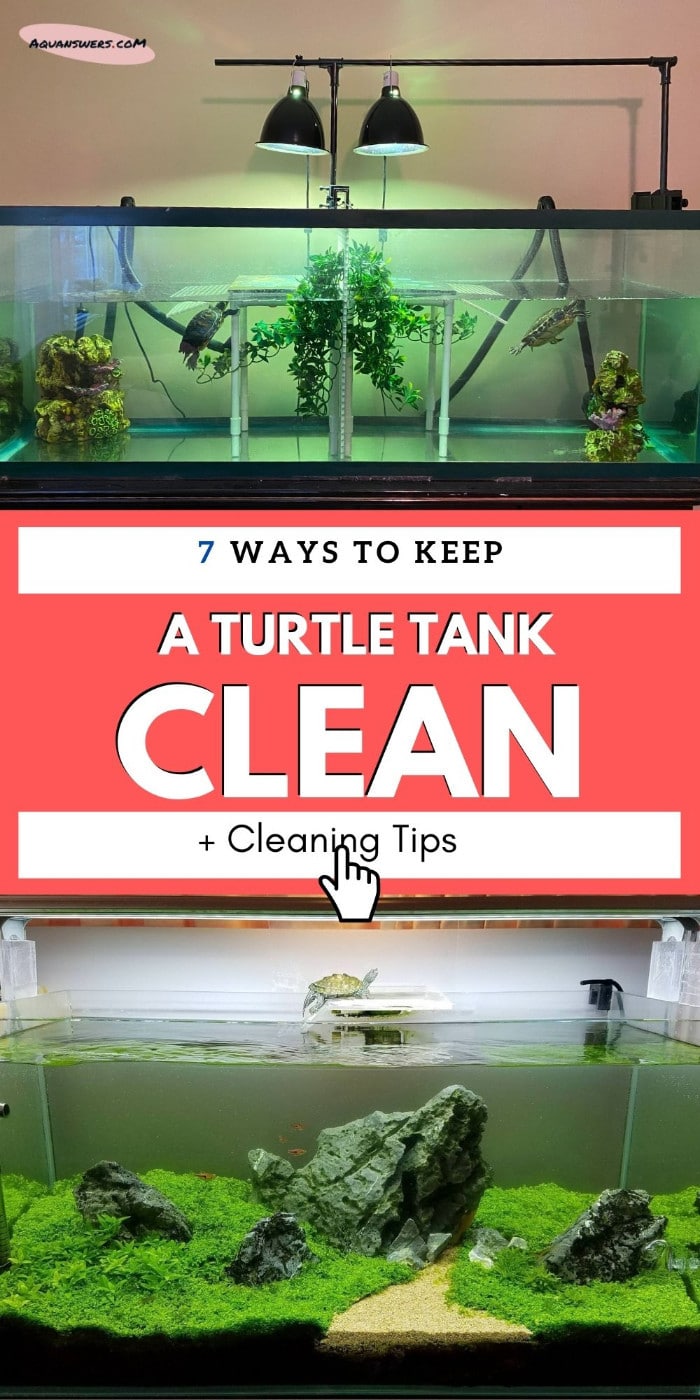

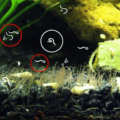
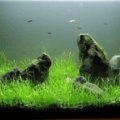
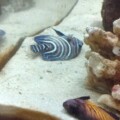

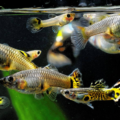


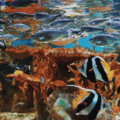
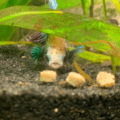
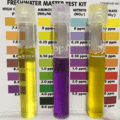
I’m getting a musk turtle this week and it will be my 1st pet turtle any advice would be welcome
Joyce,
Instead of general advice, I’d recommend that you start reading right away! Start by researching the DOs and DONTs of looking after aquatic turtles. One major tip is to research the lighting and filtration for turtle tanks. Two common issues new turtle parents come across are inadequate lighting and a smelly tank. The lighting bulb on your turtle tank should provide UVA and UVB light, and ideally, you should have another separate lamp for just heating. Finally, find people with hands-on experience in keeping specifically musk turtles (usually in forums). Ask them for things they want someone told them before getting a pet of this type.
I hope these pointers were helpful.
Happy turtle keeping, Joyce!
How do I clean the debris(green) from my old filter on the glass on on top (black part)? I now have a fluval 4.
I buy water from the water store. I have tried city water and treating it myself. The city water is tough to balance. It also stays murky after a couple days. The water from the water store is crystal clear from the beginning! I had upgraded my canister filter and that was a huge help.
What kind of vacuum do you recommend for a Turtle tank?
Hi….I have a 55 gallon tank with a red eared slider and no matter what I do I cannot keep the water clean…it turns so green. I even bought an expensive canister filter and it does nothing. Could I be that the filter is next to the tank instead of below it? (I don’t think this is the case because it is flowing properly) Any help you coul give me would be greatly appreciated. Thank you!
Hi,
What you’re seeing is continuous algae bloom. Once out of hand it’s difficult to control it, even with a good filter. What you need is a UV water clarifier. It will clean the water in 4 to 7 days and the green won’t return.
Good luck.
I highly recommend buying water from a water store. I am not sure what type of canister you have. The one I have has three trays. You can customize the filtration. Btw if you have a pet smart or pet supply they will price match chewy.com. Usually you can save $20-30 by price matching.
Hello I have a slider turtle who is messier than most. My females tank is clean and smells good, but my males tank smells bad and water changes don’t do the trick. I am unfamiliar with uv sterilizers and don’t know if they are a good idea. Also I am trying corydoras as they are bigger and are effective tank cleaners. How many gost shrimp would you recommend. I know the load on my canister is high.
Hi, UV light is a good way to keep the turtle tank water clean and sanitized. Water facilities around the world use UV light for sterilization of drinking water, if that helps your decision.
For the shrimp – you can really go overboard with the number. They have almost no bioload and will scavenge constantly. I don’t think, however, that the shrimp will help with the smell. A UV sterilizer would.
Hope this helps! Good luck!